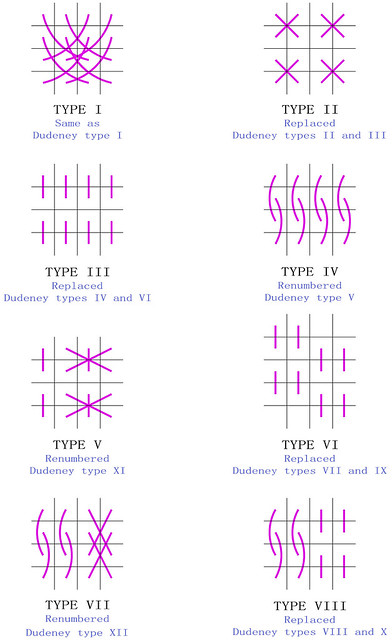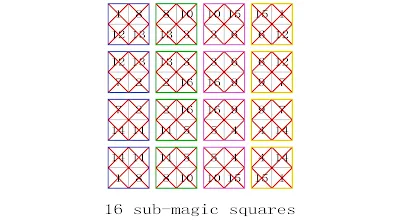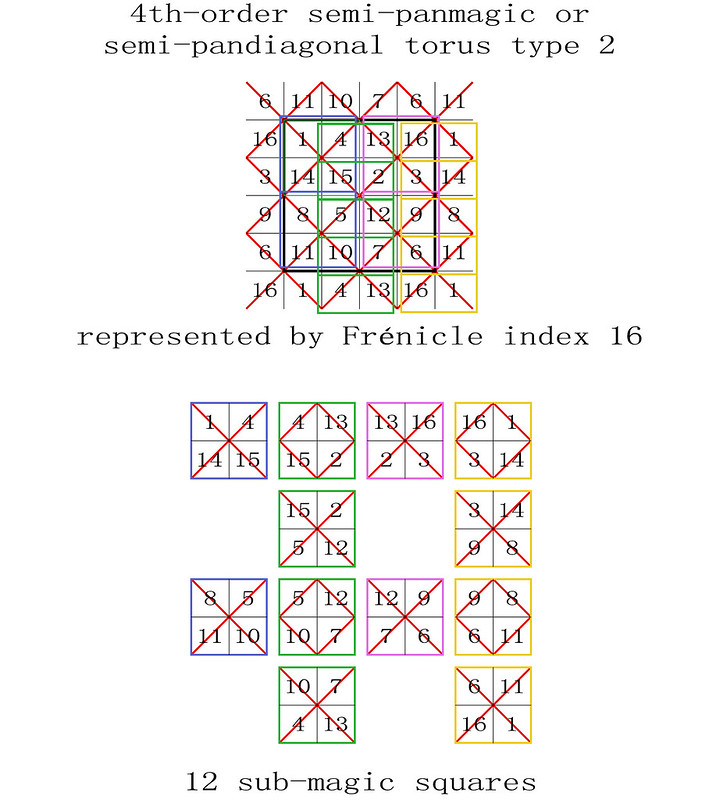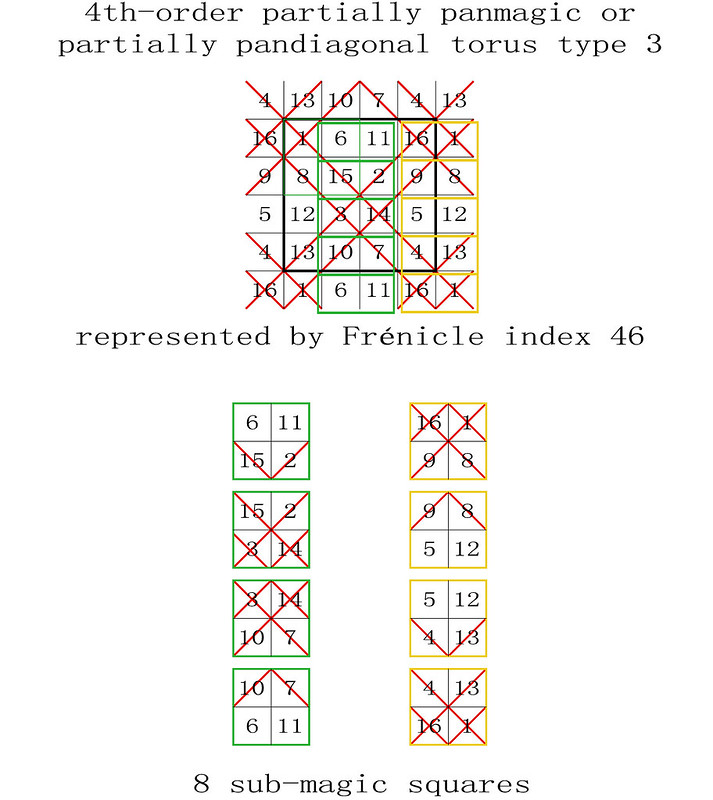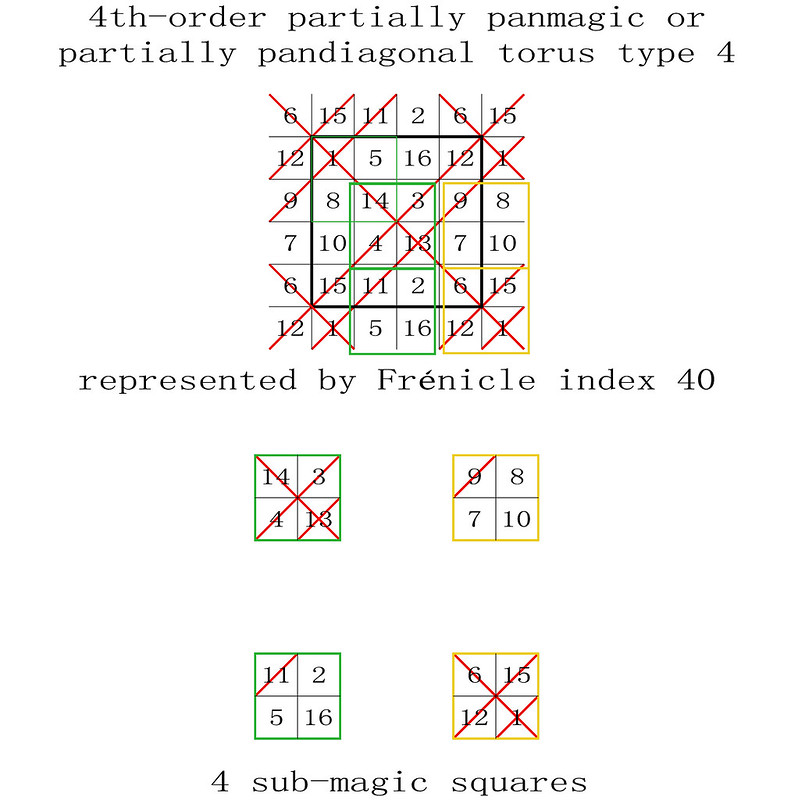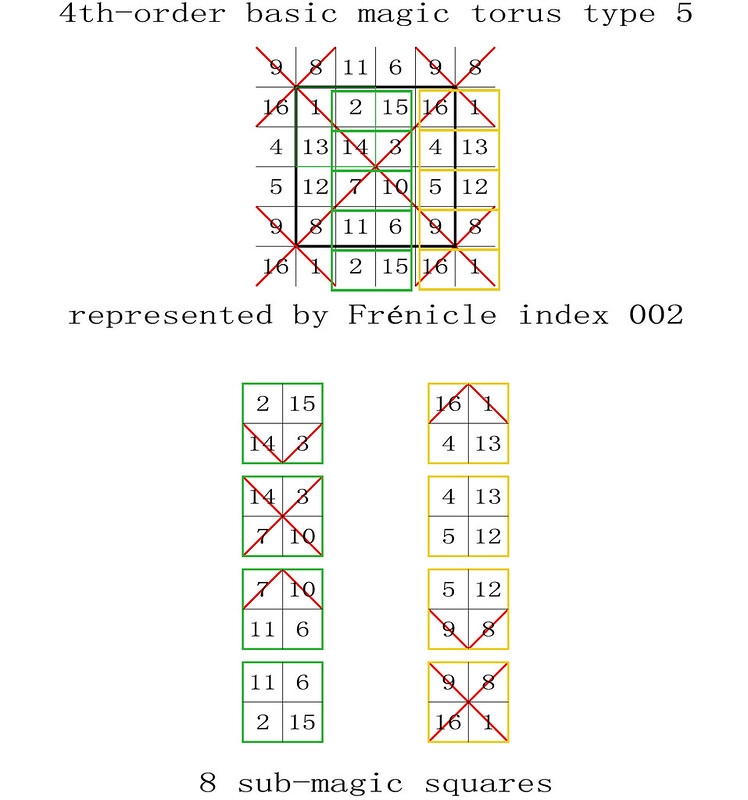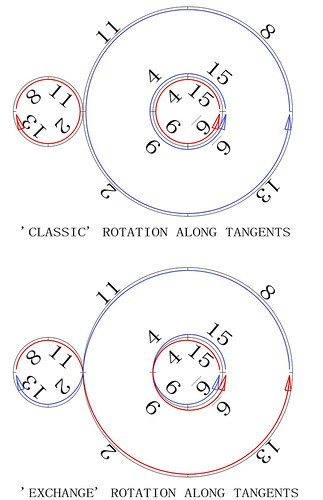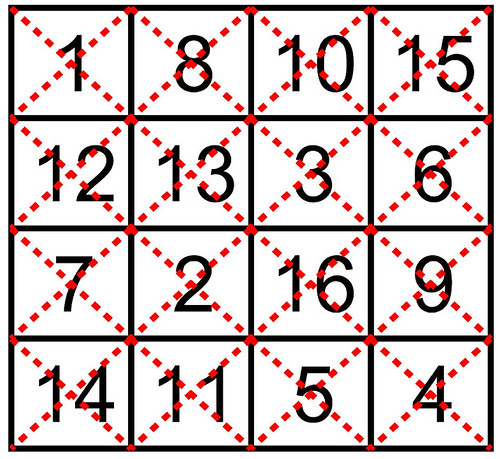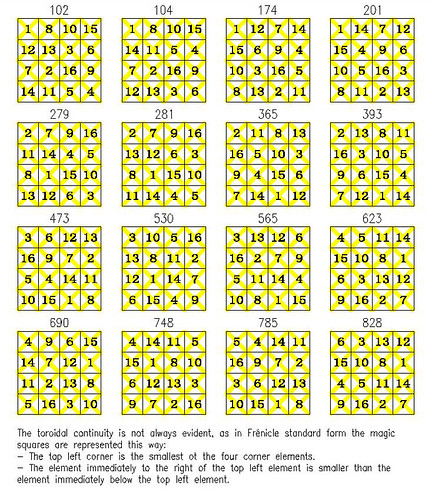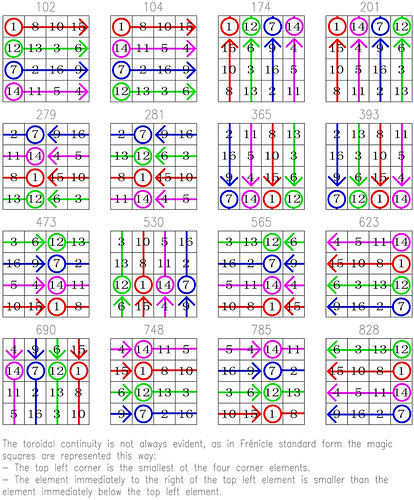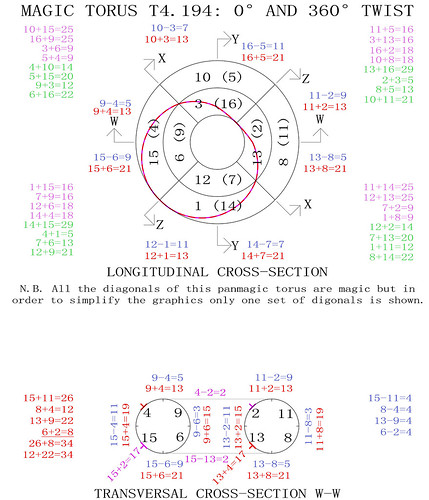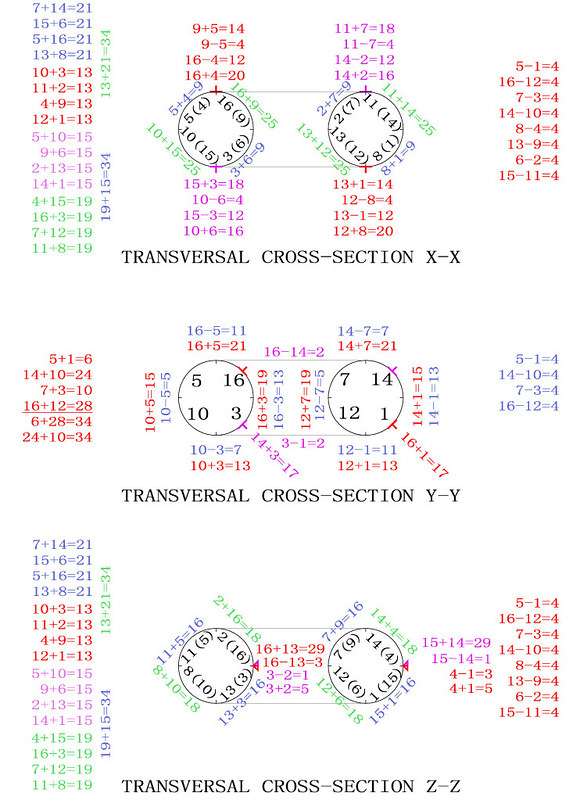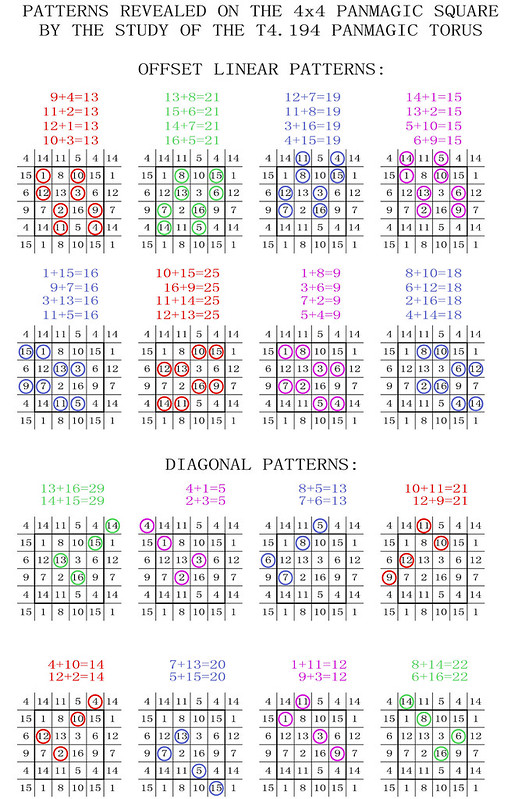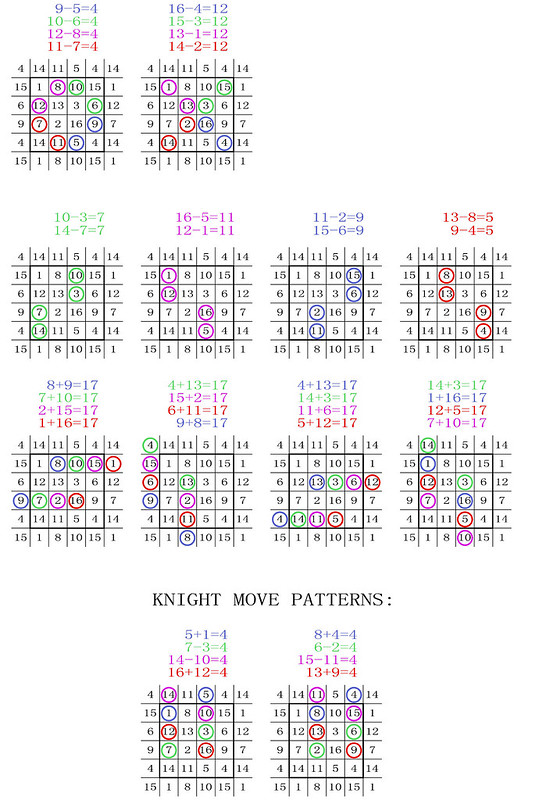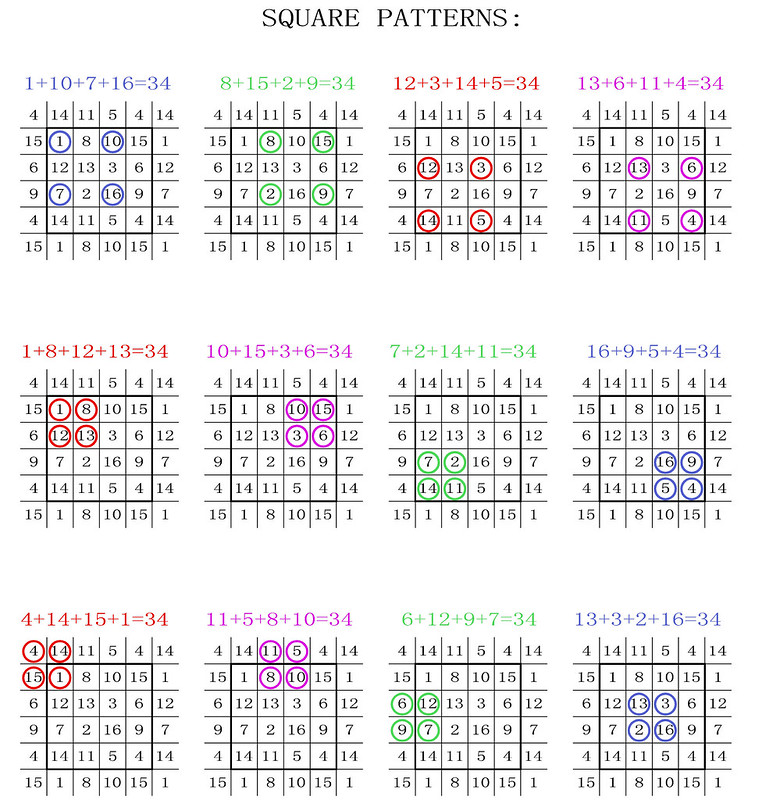The 880 fourth-order magic squares were first identified and listed by Bernard Frénicle de Bessy in his « Table générale des quarrez magiques de quatre, » which was published posthumously in 1693, in his book « Des quarrez magiques. » The census of these 880 4x4 squares is given in the appendix to the book « New Recreations With Magic Squares » by William H. Benson and Oswald Jacoby (Edition 1976), and also on the website of the late Harvey D. Heinz:
Frénicle n° 1 à 200,
Frénicle n° 201 à 400,
Frénicle n° 401 à 600,
Frénicle n° 601 à 880.
Further to Bernard Frénicle de Bessy's initial findings, Henry Ernest Dudeney then classified the 880 fourth-order magic squares under 12 pattern types, in "The Queen" in 1910, (later republished in his book
"Amusements in Mathematics" in 1917). These patterns were determined through the observation of the relative positions of complementary pairs of numbers (which add up to N²+1 when N is the order of the square).
Although the different Dudeney pattern types can indeed be observed on fourth-order magic squares, they cannot be used for the classification of the fourth-order magic tori that display these squares. A Dudeney pattern type can be misleading because it depends on a bordered magic square viewpoint, whilst the magic torus that displays the magic square has a limitless surface...
In the study that follows the complementary number patterns are therefore tested, by comparing a developed torus surface and two traditional Frénicle magic square viewpoints for each of the 12 different types of fourth-order magic tori.
Complementary number patterns of each fourth-order magic torus type
General information on the magic torus index and type numbers
In addition to the Frénicle index numbers and the Dudeney types that have already been mentioned above, the present study also uses the index and type numbers of the fourth-order magic tori. For readers who may not be acquainted with the subject, essential information can be found in the following pages:
In a previous article
"Table of Fourth-Order Magic Tori," so as to facilitate the identification of a magic torus beginning with any magic square, a standard torus form has also been defined, and each of the 255 fourth-order magic tori has received a specific index number.
Complementary number patterns of the pandiagonal tori type T4.01
The 3 pandiagonal tori type T4.01 are here represented by the pandiagonal torus with index n° T4.01.1 (torus type n° T4.01.1). This pandiagonal torus displays 16 pandiagonal squares with Frénicle index n°s 102, 104, 174, 201, 279, 281, 365, 393, 473, 530, 565, 623, 690, 748, 785 and 828. All of these squares, (including the Frénicle index n°s 102 and 174 illustrated here), show complementary number patterns that are Dudeney type I.
Complementary number patterns of the semi-pandiagonal tori type T4.02.1
The 24 semi-pandiagonal tori type T4.02.1 are here represented by the semi-pandiagonal torus with index n° T4.115 (torus type n° T4.02.1.09). This semi-pandiagonal torus displays 8 semi-pandiagonal squares with Frénicle index n°s 48, 192, 255, 400, 570, 734, 763 and 824. Half of these squares, (including the Frénicle index n° 192 illustrated here), show complementary number patterns that are Dudeney type IV. The other half, (including the Frénicle index n° 48 illustrated here), show complementary number patterns that are Dudeney type VI.
Complementary number patterns of the semi-pandiagonal tori type T4.02.2
The 12 semi-pandiagonal tori type T4.02.2 are here represented by the semi-pandiagonal torus with index n° T4.059 (torus type n° T4.02.2.01). This semi-pandiagonal torus displays 8 semi-pandiagonal squares with Frénicle index n°s 21, 176, 213, 361, 445, 591, 808 and 860. Half of these squares, (including the Frénicle index n° 21 illustrated here), show complementary number patterns that are Dudeney type II. The other half, (including the Frénicle index n° 176 illustrated here), show complementary number patterns that are Dudeney type III.
Complementary number patterns of the semi-pandiagonal tori type T4.02.3
The 12 semi-pandiagonal tori type T4.02.3 are here represented by the semi-pandiagonal torus with index n° T4.085 (torus type n° T4.02.3.01). This semi-pandiagonal torus displays 8 semi-pandiagonal squares with Frénicle index n°s 32, 173, 228, 362, 425, 577, 798 and 853. All of these squares, (including the Frénicle index n°s 173 and 228 illustrated here), show complementary number patterns that are Dudeney type V.
Complementary number patterns of the partially pandiagonal tori type T4.03.1
The 6 partially pandiagonal tori type T4.03.1 are here represented by the partially pandiagonal torus with index n° T4.108 (torus type n° T4.03.1.1). This partially pandiagonal torus displays 4 partially pandiagonal squares with Frénicle index n°s 46, 50, 337 and 545. All of these squares, (including the Frénicle index n°s 46 and 545 illustrated here), show complementary number patterns that are Dudeney type VI.
Complementary number patterns of the partially pandiagonal tori type T4.03.2
The 12 partially pandiagonal tori type T4.03.2 are here represented by the partially pandiagonal torus with index n° T4.195 (torus type n° T4.03.2.06). This partially pandiagonal torus displays 4 partially pandiagonal squares with Frénicle index n°s 208, 525, 526 and 693. Half of these squares, (including the Frénicle index n° 693 illustrated here), show complementary number patterns that are Dudeney type VII. The other half, (including the Frénicle index n° 208 illustrated here), show complementary number patterns that are Dudeney type IX.
Complementary number patterns of the partially pandiagonal tori type T4.03.3
The 2 partially pandiagonal tori type T4.03.3 are here represented by the partially pandiagonal torus with index n° T4.217 (torus type n° T4.03.3.1). This partially pandiagonal torus displays 4 partially pandiagonal squares with Frénicle index n°s 181, 374, 484 and 643. All of these squares, (including the Frénicle index n°s 484 and 643 illustrated here), show complementary number patterns that are Dudeney type XI.
Complementary number patterns of the partially pandiagonal tori type T4.04
The 4 partially pandiagonal tori type T4.04 are here represented by the partially pandiagonal torus with index n° T4.096 (torus type n° T4.04.1). This partially pandiagonal torus displays 2 partially pandiagonal squares with Frénicle index n°s 40 and 522. The square with Frénicle index n° 40 (illustrated here) shows a complementary number pattern that is Dudeney type VIII, whilst the other square with Frénicle index n° 522 (illustrated here) shows a complementary number pattern that is Dudeney type X.
Complementary number patterns of the basic magic tori type T4.05.1
The 92 basic magic tori type T4.05.1 are here represented by the basic magic torus with index n° T4.002 (torus type n° T4.05.1.01). This basic magic torus displays 2 basic magic squares with Frénicle index n°s 1 and 458. Both of these squares, illustrated here, show complementary number patterns that are Dudeney type VI.
Complementary number patterns of the basic magic tori type T4.05.2
The 32 basic magic tori type T4.05.2 are here represented by the basic magic torus with index n° T4.049 (torus type n° T4.05.2.01). This basic magic torus displays 2 basic magic squares with Frénicle index n°s 23 and 767. The square with Frénicle index n° 767 (illustrated here) shows a complementary number pattern that is Dudeney type VII, whilst the square with Frénicle index n° 23 (illustrated here) shows a complementary number pattern that is Dudeney type IX.
Complementary number patterns of the basic magic tori type T4.05.3
The 4 basic magic tori type T4.05.3 are here represented by the basic magic torus with index n° T4.005 (torus type n° T4.05.3.1). This basic magic torus displays 2 basic magic squares with Frénicle index n°s 3 and 613. Both of these squares, illustrated here, show complementary number patterns that are Dudeney type XII.
Complementary number patterns of the basic magic tori type T4.05.4
The 52 basic magic tori type T4.05.4 are here represented by the basic magic torus with index n° T4.019 (torus type n° T4.05.4.1). This basic magic torus displays 2 basic magic squares with Frénicle index n°s 8 and 343. The square with Frénicle index n° 8 (illustrated here) shows a complementary number pattern that is Dudeney type VIII, whilst the square with Frénicle index n° 343 (illustrated here) shows a complementary number pattern that is Dudeney type X.
Conclusions
We can see that the Dudeney pattern types I, V, XI, and XII are not only valid for magic squares, but also for the magic tori that display these squares. On the other hand, the Dudeney pattern types II and III are shown to be partial viewpoints of a single pattern on the fourth-order magic tori. Again, the Dudeney pattern types IV and VI, the Dudeney pattern types VII and IX, and also the Dudeney pattern types VIII and X, are shown to be partial viewpoints of single patterns on the fourth-order magic tori.
We also notice that some of the detected complementary number patterns have contrasting hemitorus arrangements.
It is necessary to adapt the Dudeney pattern types, and add new symbols that not only reveal the real nature of the complementary number relationships, but also facilitate their comprehension. With this in mind, the 8 figures that follow have been selected to illustrate the essentially different complementary number pattern types that occur on fourth-order magic tori:
To be read with a previous table that compared the 12 Dudeney pattern types with the 12 Magic torus types, published in
"A New Census of Fourth-Order Magic Squares," the new table that follows, recapitulates the latest findings, and shows the repartition of the 8 complementary number patterns on the magic squares of the fourth-order magic tori:

Further Developments

























